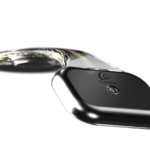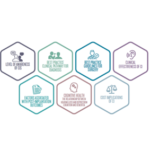Did you know that being actively involved in managing your hearing health can make a difference in your outcomes?1,2,3
Research shows that using information, tools and activities that are easy to use and understand, and that are shaped to individual needs, makes a difference.4
Digital tools are making this easier by providing patients with access to knowledge, tools and strategies to better manage their hearing loss. They can practice skills at home, track progress, build knowledge and achieve the outcomes that matter most. Cochlear™ CoPilot is our latest digital tool developed as a self-guided app designed for iPhone®.
The app features information from clinical experts and recipients, as well as interactive skill-building activities to help build listening confidence.
Here are six reasons to try Cochlear CoPilot:
Active practice can help
Our brains continue to change and adapt throughout our life as a result of experience.5,6,7 Adults can learn new skills, but often require focused attention or active practice to learn.8
Cochlear CoPilot has been designed with this in mind and features skill training to support auditory learning through active engagement and focused attention.
The app puts the patient in the driver’s seat
Self-managing hearing loss is shown to be one of the key components of successful rehabilitation.3 This is especially important as patients may not have access to hearing health experts 24/7.
As an app, CoPilot allows self-selected content and activities suited to personal needs and takes an active role in managing the hearing health journey at a pace that suits the patient.
It delivers content relevant to the individual
Because everyone’s hearing loss experience and life stage is different, rehabilitation is not a one-size-fits-all approach. Instead, it should be shaped by personal requirements – needs, interests, abilities and preferences.
Created with feedback
The app has been developed with input from people with cochlear implants –those who have recently had surgery, as well as those who have had their implant for many years.
This helps to ensure the app’s features and content are relevant to the real-world needs of everyone using the app. There are also personal stories, practical tips and support from others who are cochlear implant recipients.
The app updates with new features, information and activities that are relevant as the hearing journey progresses.
Engaging and easy for your patients to use
Cochlear CoPilot has been designed to be visually engaging, using plain language presented in easy-to-use chunks that focus on concrete actions and skills. It also features videos and interactive exercises to support adult learning.
The app is easy to use and simple to download, no matter age or level of comfort with technology.
It fits into your patients’ daily life
Cochlear CoPilot is designed to fit into the patients’ lifestyles. With everything in one place, it can be used whenever, wherever or while on the go at their own pace.
Get started today! Download Cochlear CoPilot for free from the Apple® App Store®.
References
1.Feste C, Anderson RM. Empowerment: from philosophy to practice. Patient Educ Couns. 1995;26(1-3):139-144. doi:10.1016/0738-3991(95)00730-n
2.Milijana Malmberg, Elisabet Sundewall Thorén, Marie Öberg, Thomas Lunner, Gerhard Andersson & Kim Kähäri (2018) Experiences of an Internet-based aural rehabilitation (IAR) program for hearing aid users: a qualitative study, International Journal of Audiology, 57:8, 570-576, DOI: 10.1080/14992027.2018.1453171
3. Convery E, Keidser G, Hickson L, Meyer C. The Relationship Between Hearing Loss Self-Management and Hearing Aid Benefit and Satisfaction. Am J Audiol. 2019;28(2):274-284. doi:10.1044/2018_AJA-18-0130
4.Caposecco A, Hickson L, Meyer C. Hearing aid user guides: suitability for older adults. Int J Audiol. 2014;53 01:S43–S51. [PubMed]
5. Anderson, S., & Kraus, N. (2013). Auditory training: Evidence for neural plasticity in older adults. SIG 6 Perspectives on Hearing and Hearing Disorders: Research and Diagnostics, 17, 37-57. https://doi.org/doi:10.1044/hhd17.1.37
6. Zendel B, West GL, Belleville S, Peretz I (2019) Musical Training improves the ability to understand speech-in-noise in older adults . Neurobiology of aging. 81() 102-115 September
7. Pascual-Leone, A., Amedi, A., Fregni, F., & Merabet, L. B. (2005). The plastic human brain cortex. Annual Review of Neuroscience, 28, 377-401.
8. Drouin, J. R., & Theodore, R. M. (2020). Leveraging interdisciplinary perspectives to optimize auditory training for cochlear implant users. Language and Linguistics Compass. https://doi.org/10.1111/lnc3.12394
ACE, Advance Off-Stylet, AOS, AutoNRT, Autosensitivity, Beam, Bring Back the Beat, Button, Carina, Cochlear, 科利耳, コクレア, 코클리어, Cochlear SoftWear, Codacs, Contour, Contour Advance, Custom Sound, ESPrit, Freedom, Hear now. And always, Hugfit, Hybrid, Invisible Hearing, Kanso, MET, MicroDrive, MP3000, myCochlear, mySmartSound, NRT, Nucleus, Outcome Focused Fitting, Off-Stylet, Slimline, SmartSound, Softip, SPrint, True Wireless, the elliptical logo, and Whisper are either trademarks or registered trademarks of Cochlear Limited. Ardium, Baha, Baha SoftWear, BCDrive, DermaLock, EveryWear, SoundArc, Vistafix, and WindShield are either trademarks or registered trademarks of Cochlear Bone Anchored Solutions AB.
For compatibility information visit www.cochlear.com/compatibility
Apple, the Apple logo, Apple Watch, FaceTime, Made for iPad logo, Made for iPhone logo, Made for iPod logo, iPhone, iPad Pro, iPad Air, iPad mini, iPad and iPod touch are trademarks of Apple Inc., registered in the U.S. and other countries. App Store is a service mark of Apple Inc., registered in the U.S. and other countries.


